Table of contents

Markus Jahn
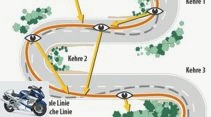
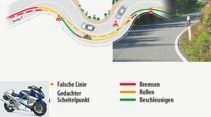
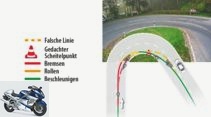
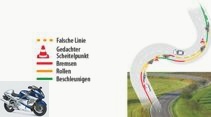
26th pictures
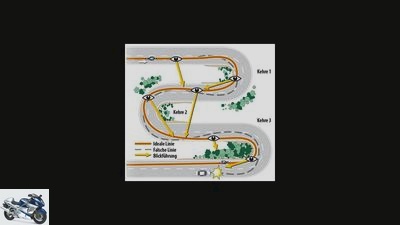
MOTORCYCLE
1/26
On the way on alpine passes? That’s how it works!
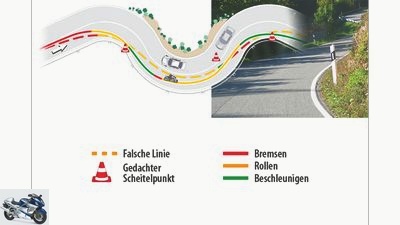
MOTORCYCLE
2/26
Seductive winding curves with risk. The course of the road cannot be seen for the most part, which is why a car or motorcycle can appear unexpectedly – uncomfortable to dangerous when you cut the curves. The so-called undercutting of the curves is therefore better, especially since you always have to expect that a driver in oncoming traffic will cut the S-curve and, in the worst case, come along on the wrong side of the road. If we have then cut the curve ourselves, our chances are extremely slim.
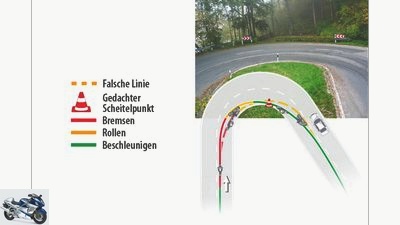
MOTORCYCLE
3/26
The classic curve, which allows a finely arranged ideal line and corresponding leanings due to its clarity. However, if you cut the curve (dashed line), the motorcycle must drive the greatest lean angle at the exit of the curve, if you do not want to go on a collision course with possible oncoming traffic. In the case of undercutting (solid line), on the other hand, the apex is later (pylons). You can see better around the bend, which is why you can accelerate much earlier on the flatter line, which more than makes up for the slightly slower cornering speed.
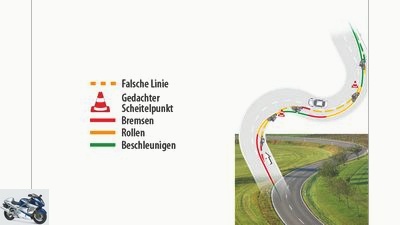
MOTORCYCLE
4/26
In alternating curves, the advantage of undercutting comes into play even more, because the apex, which is set late in the right-hand bend, allows the following left-hand bend to be approached from far outside. The driver on the wrong line (dashed) is pushed in the direction of the opposite lane, and he has to turn hard from an extremely unfavorable position for the following left-hand bend. A liquid, round line cannot be made with it.
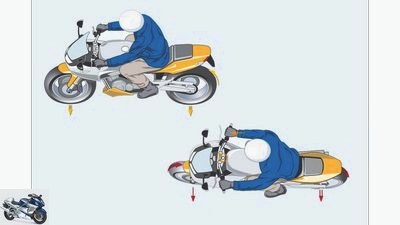
MOTORCYCLE
5/26
The three phases of cornering.
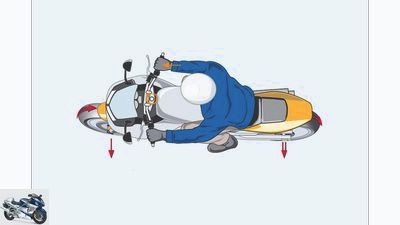
MOTORCYCLE
6/26
Red phase: Adaptive braking before turning. Turning in on the brakes is critical, because many machines, especially those with wide tires, cause an erection torque.
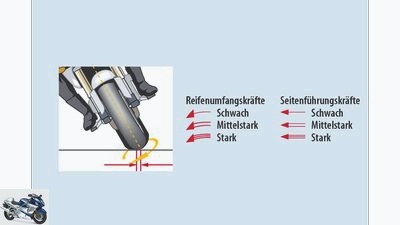
MOTORCYCLE
7/26
The contact area of the front tire moves out of the wheel center plane (see yellow dashed line) and the motorcycle tries to straighten up. The driver has to compensate for this phenomenon by counter-steering. In our driving tests, a necessary counter-steering force of up to 250 Newton meters was found at a twelve degree incline.

MOTORCYCLE
8/26
Yellow phase: Lean during the roll phase. In this driving state, the circumferential forces on the front wheel are very low, while the driving force acts on the rear wheel depending on the constant speed – at 100 km / h around eight hp. The tires can now transfer high lateral forces and thus cope with an enormous lean angle. If the lean angle is too great, the tires lose their grip, usually the narrower front tire first. Conversely, too low cornering speed can lead to overturning; Early easy acceleration helps.
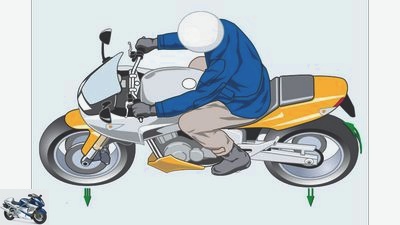
MOTORCYCLE
9/26
Green phase: Accelerate from a lean angle. At the exit of the curve, the gas is gently drawn up, causing the motorcycle to stand up and the curve radius increases. If you want to push the straightening up, additional pressure at the end of the handlebars on the outside of the curve helps. Depending on the acceleration, a more or less strong circumferential force acts on the rear tire. This is why it can withstand less lateral forces and therefore lean angles than the front tire, which guarantees safe lateral guidance in an inclined position.
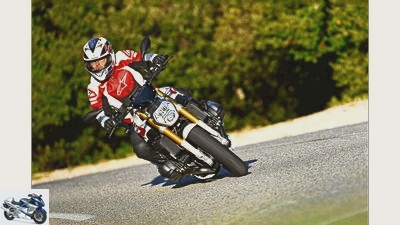
Gargolov
10/26
The classic – lean into the curve: the driver and machine form a line when tilted. Either with a firm knee or a relaxed, sporty knee, this driving style is suitable for all types of curves at any speed. The direction of travel can be corrected very quickly, from laying down you can seamlessly switch to pushing in alternating curves. The relaxed posture does not require much strength. Good to see here: The driver bends his head to keep his horizon as straight as possible, his gaze is directed towards the exit of the curve.
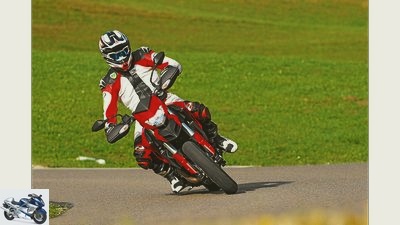
Bilski
11/26
Push: This curve technique originally comes from off-road sports. The driver remains relatively upright, the motorcycle is pushed down with the handlebars. Hip bend and firm knee closure help. This works well in tight bends and serpentines, with quick changes of course or evasive maneuvers. Ideal for gravel roads and on loose or slippery surfaces because the body’s center of gravity is above the tire contact area.
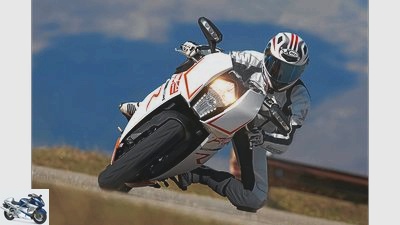
jkuenstle.de
12/26
Hanging-off: This driving style is tailored to the seating position and chassis geometry of super athletes and is mainly used on the racetrack, where the further course of the route is known. With the same cornering speed, it requires less lean angle, but strength and a lot of practice. The photos show that, regardless of the cornering style, a motorcycle needs considerably more space than when driving straight ahead, which is why you should never get too close to the center of the lane when cornering to the left. And to the right, the delineator posts lurk for (athlete) mirrors rushing past too closely.

MOTORCYCLE
13/26
You should avoid this mistake.
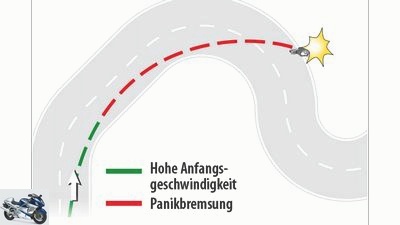
MOTORCYCLE
14/26
This mistake should also be avoided: Too high an initial speed and panic braking.
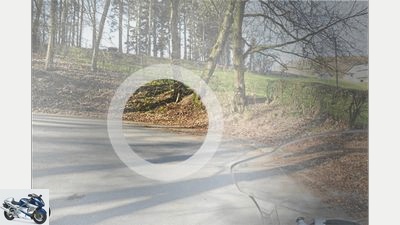
Streblow
15/26
Correct viewing is often difficult uphill. The dirt on the right-hand side of the lane also first demands attention and thus draws attention to itself.
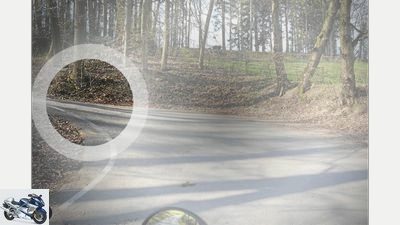
Streblow
16/26
Now it’s time to “keep your head up” and look uphill to see if there is oncoming traffic and how the road will continue. We don’t see yet what the next picture shows.
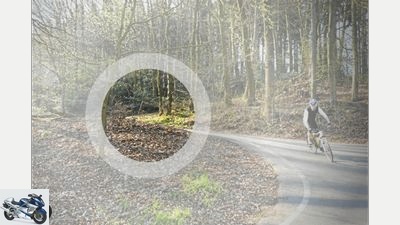
Streblow
17/26
Looking ahead at an early stage prevents us from being frightened by the now emerging cyclist and allows us to perceive the following right-hand bend in good time.
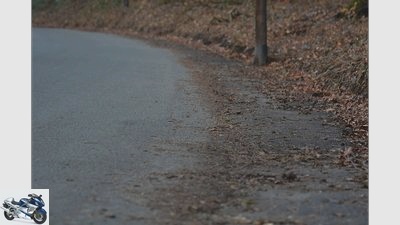
Streblow
18/26
In left-hand bends, the lane can get really narrow. Because if we drove too far to the left we would come into oncoming traffic, and on the right edge of the road there were leaves, gravel and other rubbish. You should stay away from this as much as possible in an inclined position.
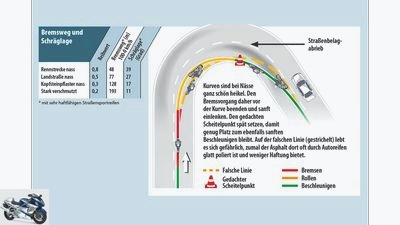
MOTORCYCLE
19/26
The measured values of a Honda CBR 600 F show how different road surfaces in the rain affect the braking distance and the possible lean angle. The braking distance is hardly longer on grippy racetrack asphalt than on dry slopes. On the wet country road, however, the sports touring bike needs 77 meters to brake hard from 100 km / h, and significantly more if the surface is poor. In addition, the possible inclination is drastically reduced.
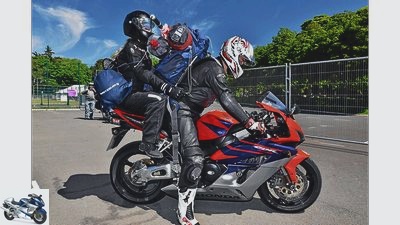
MOTORCYCLE
20/26
Topic loading:
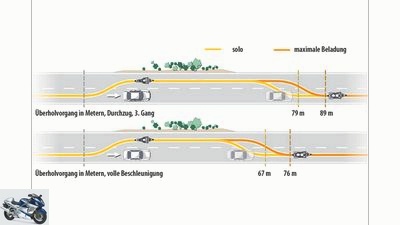
MOTORCYCLE
21/26
A fully loaded motorcycle is slower and less powerful than a machine on which only the driver is sitting. Actually clear, but in the heat of the curve fight on the country road you sometimes forget that, especially when the tour for two and with luggage is more the exception than the rule. The two examples above use a Suzuki GSX 1250 FA to show that overtaking with a load takes significantly longer. The Suzi has at least 98 hp and remains relatively powerful; with weak engines, the path can even double.
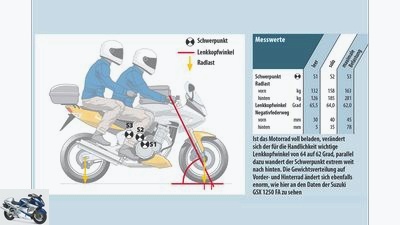
MOTORCYCLE
22/26
Important: The chassis must be adjusted when loading.

Bilski
23/26
Leaning under a load is hard work for the rear tire. If there is still too little air in it, the rear of the machine can really rock up.
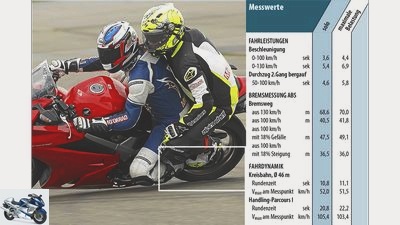
Bilski
24/26
When loaded, the performance and braking behavior of a motorcycle change. Since there is significantly more weight on the rear wheel than normal, the front wheel becomes light when you accelerate and lifts off noticeably earlier. Depending on the tires, handlebar flutter (shimmy) can increase between 60 and 100 km / h. Therefore: Do not drive hands-free or with only one hand on the handlebars when the vehicle is loaded. Anyone traveling in the Alps should take into account that the braking distance increases on steep inclines, as shown by braking measurements with a Honda VFR 800. The other measurement data show that the acceleration and, above all, the pulling power of the almost five hundred pound heavy sports tourer deteriorate significantly – take into account when overtaking!

manufacturer
25/26
Sitting position: If, as here, only the tips of your toes reach the floor, it is not enough to just reduce the spring base on the fork and shock absorber. Because not only is the progress too little, such a suspension setting also leads to unsatisfactory driving characteristics.

manufacturer
26/26
The lowering kit and the extra-deep seat bring real progress. In the case of the BMW F 800 GS, other fork springs that match the shortened rear shock are installed at the front. All in all, the seat height is reduced by around 70 millimeters.
accesories
tire
The right tire choice for a motorcycle
The right choice of tires
Enduro, touring or sports tires?
Motorcycles ride well and safely
Tires are seldom the focus and are accordingly given little attention. That is a shame, because they are the only contact surface between the motorcycle and the road, so they are solely responsible for giving direction and stability to the journey.
Nicolas Streblow
04/02/2019
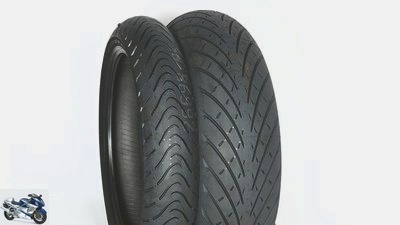
mps photo studio
A touring tire with extreme grip reserves in the wet is the agile Metzeler Roadtec 01
Black, round, dirty, and mostly flabby or without a profile at the wrong time: motorcycle tires. Their grip enables us to enjoy the joys of acceleration and banking, as well as the performance of modern brakes. And some people suspected damage to the motorcycle or their own incapacity, where only unsuitable or worn tires, possibly with too little air, had screwed up the line. Because motorcycle tires should have a sufficient profile and the air pressure specified in the manual.
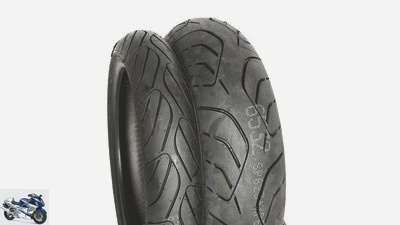
mps photo studio
As a touring tire, the Dunlop Roadsmart III lasts a long time, but doesn’t particularly like rain.
It is often surprising how different two identical motorcycles can drive with different tires. During the MOTORRAD tire test, a standardized route with data recording is driven in the same way over and over again. In this way, the testers can find out the differences between tire pairings and give recommendations for the individual machines.
One and the same tire can, however, work fine on one motorcycle, but not be very enjoyable on another. Profile, tire contour, rubber compound, vehicle geometry and other factors together result in a well or less well-fitting mixture.

manufacturer
A sports tire like the Pirelli Diablo Rosso shines best on a sporty drive in the dry.
The purpose of use also needs to be considered. A great sports tire, which only unfolds its good properties at higher temperatures, slips through the area completely unsteady on a cool rain tour.
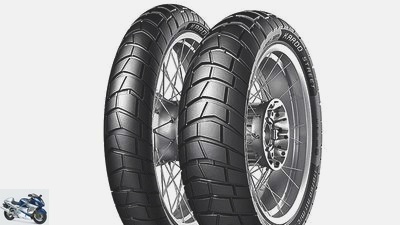
A moderate studded tire like the Metzeler Karoo Street must also work on the road
Anyone who has fitted fat knobby tires because it might look cool or because they really want to hit the gravel has to expect longer braking distances and slides in bends on asphalt and especially when wet. You also have to get used to the sometimes wobbly steering behavior.
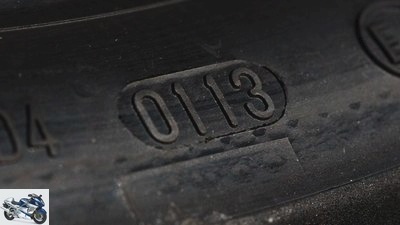
Artist
Each tire has its date of birth. The sequence of digits 0113 stands for production in January 2013
In addition, brilliant wet grip and extreme durability are rarely combined in the same tire. Because hard rubber does not adhere well to wet roads. A problem that tires that are too old can also have. Even if the profile is still good after 2000 kilometers and ten years, such a rubber should be removed – for the sake of your own safety.
Related articles
-
What is the best motorcycle sports tire of 2015?
mps photo studio 11 pictures mps photo studio 1/11 The RS 10 is a very decent skin with many strengths and without significant weaknesses. Accordingly,…
-
Correct cornering with the motorcycle
Jahn 28 pictures Kawasaki 1/28 Curves are the icing on the cake for motorcyclists. Without them, life on two wheels would be bland. Muller 2/28 3. Green…
-
The fascination of cornering on a motorcycle
Werel Sports & scene Motorsport The fascination of cornering on a motorcycle The fascination of cornering on a motorcycle And the curve beckons forever…
-
archive counselor technology & future Lateral and circumferential forces when riding a motorcycle – driving physics when riding a motorcycle About…
-
Driving physics of the motorcycle tire Kammscher Kreis
Illustration: Muller counselor Driving experience & Driving tips Driving physics of the motorcycle tire Kammscher Kreis The Kamm circle Physical basics…
-
Eleven motorcycle tire warmers in a comparison test
mps photo studio 48 pictures mps photo studio 1/48 Eleven motorcycle tire warmers in a comparison test. Yvonne Hertler 2/48 The test bikes were donated…
-
Driving tips: Warm up the motorcycle properly
jkuenstle.de counselor workshop Driving tips: Warm up the motorcycle properly This is how it works: Warm up the motorcycle properly How to get your bike…
-
MOTORCYCLE tips for racetrack training
jkuenstle.de counselor workshop MOTORCYCLE tips for racetrack training Tips for newcomers to the racetrack Always nice and slow You’ve got your hands on…
-
How does the tire width affect driving behavior?
accesories tire How does the tire width affect driving behavior?? How does the tire width affect driving behavior?? How does the tire width affect…
-
PS reader question on motorcycle technology – tire wear on the racetrack
jkuenstle.de 5 pictures markus-jahn.com 1/5 “What is the reason for the flaky, frayed way in which racing tires are destroyed??”, asks us reader Holger…